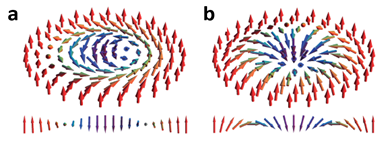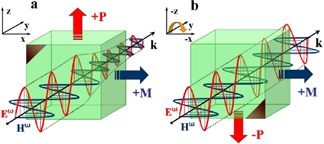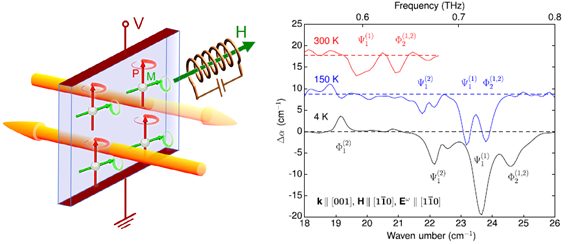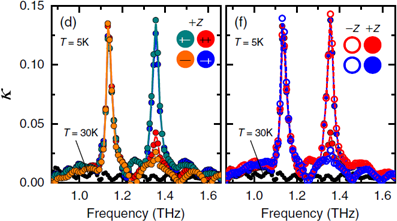Our research group investigates magnetic materials with strong coupling between their spin, charge and lattice degrees of freedom. In the studied interacting spin systems, the spin-orbit and/or spin-lattice couplings gives rise to novel exotic phenomena like the magnetoelectric effect, the optical diode effect, the emergence of magnetic skyrmions. The new functionalities of these complex magnets enables their application in magnetic data storage, optical telecommunication or GHz/THz technology.
Magnetic skyrmions
Magnetic skyrmions are spin textures with non-trivial topology arising from competing magnetic interactions. The nontrivial skyrmion topology is evidenced when its spin pattern is mapped onto a sphere, and the mapping wraps the surface of the sphere entirely.

Magnetic skyrmions were observed in cubic chiral helimagnets for the first time. These skyrmions are whirlpool-like, Bloch skyrmions, which form a stable lattice in a narrow pocket of the phase diagram. Our research group observed hedgehog-like Néel skyrmions in bulk magnets like GaV4S8 and GaV4Se8. Applying atomic force microscopy (AFM) we detected dot like magnetic objects on the surface of these compounds whereas we used small-angle neutron scattering (SANS) to confirm the existence of modulated phases in the bulk. We found that the polar symmetry of these compounds allowing only cycloidal modulation provides enhanced stability for the skyrmion lattice phase.
J. S. White, Á. Butykai, R. Cubitt, D. Honecker, C. D. Dewhurst, L. F. Kiss, V. Tsurkan and S. Bordács
PHYSICAL REVIEW B 97, 020401 (2018) - EDITOR’S SUGGESTION
Equilibrium Skyrmion Lattice Ground State in a Polar Easy-plane Magnet
S. Bordács, Á. Butykai, B. G. Szigeti, J. S. White, R. Cubitt, A. O. Leonov, S. Widmann, D. Ehlers, H. A. K. von Nidda, V. Tsurkan, A .Loidl and I. Kézsmárki
SCIENTIFIC REPORTS 7, 7584 (2017)
Néel-type Skyrmion Lattice with Confined Orientation in the Polar Magnetic Semiconductor GaV4S8
I. Kézsmárki, S. Bordács, P. Milde, E. Neuber, L. M. Eng, J. S. White, H. M. Rønnow, C. D. Dewhurst, M. Mochizuki, K. Yanai, H. Nakamura, D. Ehlers, V. Tsurkan and A. Loidl
NATURE MATERIALS 14, 1116 (2015)
Magnetoelectric multiferroics
When both the time-reversal and the spatial inversion symmetries are broken the magnetoelectric effect is allowed, i.e. an electric field can induce magnetism and a magnetic field can generate polarization. In multiferroic materials, which exhibit coexisting ferroelectric and magnetic orders, this weak relativistic effect is enhanced. Since multiferroics enable an efficient electric field control of the magnetization, they can find applications in low-dissipation memory devices and magnetic field sensors.

Our group demonstrated that the finite frequency magnetoelectric coupling gives rise to novel optical effects in multiferroics. We studied the spin excitations of these compounds by THz spectroscopy and observed e.g. magnetoelectric polarization rotation and non-reciprocal direction dichroism. The latter effect, which is the light absorption difference for counter propagating light beams, can open new possibilities for the applications of multiferroics in optical diode.
Unidirectional terahertz light absorption in the pyroelectric ferrimagnet CaBaCo4O7
S. Bordács, V. Kocsis, Y. Tokunaga, U. Nagel, T. Rõõm, Y. Takahashi, Y. Taguchi, and Y. Tokura,
PHYSICAL REVIEW B 92, 214441 (2015)
One-way Transparency of Four-coloured Spin-wave Excitations in Multiferroic Materials
I. Kézsmárki, D. Szaller, S. Bordács, V. Kocsis, Y. Tokunaga, Y. Taguchi, H. Murakawa, Y. Tokura, H. Engelkamp, T. Rõõm, and U. Nagel
NATURE COMMUNICATIONS 5, 3203 (2014)
Chirality of matter shows up via spin excitations
S. Bordács, I. Kézsmárki, D. Szaller, L. Demkó, N. Kida, H. Murakawa, Y. Onose, R. Shimano, T. Rõõm, U. Nagel, S. Miyahara, N. Furukawa, and Y. Tokura
NATURE PHYSICS 8, 734 (2012)
PHYSICAL REVIEW LETTERS 106, 057403 (2011)

We observed non-reciprocal directional dichroism even in the room temperature multiferroic compound BiFeO3. The systematic study of the selection rules and the magnetic field dependence of the spin excitations motivated us to investigate the cycloidal magnetic structure of this compound by small-angle neutron scattering (SANS). We found a magnetic field induced rearrangement of the cycloidal spin structure. The cycloid propagation vectors are rotated when magnetic fields applied perpendicular to the rhombohedral (polar) axis exceed a pinning threshold value of ∼5 T. In light of these experimental results, we proposed a phenomenological model that captures the rearrangement of the cycloidal domains. Furthermore, we revisit the microscopic origin of the magnetoelectric effect and proposed a new coupling between the magnetic anisotropy and the polarization.
Magnetic Field Control of Cycloidal Domains and Electric Polarization in Multiferroic BiFeO3
S. Bordács, D. G. Farkas, J. S. White, R. Cubitt, L. DeBeer-Schmitt, T. Ito, and I. Kézsmárki
PHYSICAL REVIEW LETTERS 120, 147203 (2018)
Optical Diode Effect at Spin-Wave Excitations of the Room-Temperature Multiferroic BiFeO3
I. Kézsmárki, U. Nagel, S. Bordács, R.S. Fishman, J.H. Lee, Taek Yi Hee, S.-W. Cheong, and T. Rõõm
PHYSICAL REVIEW LETTERS 115, 127203 (2015)

In LiCoPO4 we demonstrated the optical identification of magnetoelectric antiferromagnetic (AFM) domains exploiting the strong absorption difference between the domains. This non-volatile contrast also present in zero magnetic field. We detected strong non-reciprocal directional dichroism, when a single domain is selected by external electric and magnetic fields.
Identification of Antiferromagnetic Domains Via the Optical Magnetoelectric Effect
V. Kocsis, K. Penc, T. Rõõm, U. Nagel, J. Vít, J. Romhányi, Y. Tokunaga, Y. Taguchi, Y. Tokura, I. Kézsmárki, and S. Bordács
PHYSICAL REVIEW LETTERS 121, 057601 (2018)

